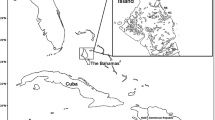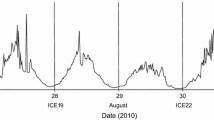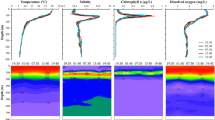Abstract
We report results of a field test of the predator avoidance hypothesis as an explanation of the adaptive significance of diel vertical migration in zooplankton. We determined the vertical distribution and diel migration of the planktonic copepod Acartia hudsonica, concurrently with the abundance of pelagic fish, transparency and thermal stratification of the water column, on six cruises over a one year period in a temperate marine lagoon (Jakles Lagoon, San Juan Island, Washington, USA). Striking seasonal variability was observed in all biological and environmental variables. Linear regressions of the strength of diel vertical migration in A. hudsonica on these environmental variables resulted in only one statistically significant relationship, that between copepod diel vertical migration and predator abundance. These results, together with those of previous studies, point to diel vertical migration as a widespread behavioral response of planktonic prey to the presence of their predators.
Similar content being viewed by others

References
Bollens, S. M. & B. W. Frost, 1989a. Zooplanktivorous fish and variable diel vertical migration in the marine planktonic copepod Calanus pacificus. Limnol. Oceanogr. 34: 1072–1083.
Bollens, S. M. & B. W. Frost, 1989b. Predator-induced diel vertical migration in a planktonic copepod. J. Plankton Res. 11: 1047–1065.
Bollens, S. M. & B. W. Frost, In Press. Diel vertical migration in zooplankton: rapid individual response to predators. J. Plankton Res.
Crivelli, A. J. & R. H. Britton, 1987. Life history adaptations of Gasterosteus aculeatus in a Mediterranean wetland. Envir. Biol. Fishes 18: 109–125.
De Meester, L. & H. J. Dumont, 1988. The genetics of phototaxis in Daphnia magna: existence of three phenotypes for vertical migration among parthenogenetic females. Hydrobiologia 162: 47–55.
Frost, B. W., 1988. Variability and possible adaptive significance of diel vertical migration in Calanus pacificus, a planktonic marine copepod. Bull. mar. Sci. 43: 675–694.
Gabriel, W. & B. Thomas, 1988. Vertical migration of zooplankton as an evolutionary stable strategy. Am. Nat. 132: 199–216.
Giles, N., 1987. Population biology of the three-spined sticklebacks, Gasterosteus aculeatus, in Scotland. J. Zool. 212: 255–265.
Gliwicz, M. Z. & J. Pijanowska, 1988. Effect of predation and resource depth distribution on vertical migration of zooplankton. Bull. mar. Sci. 43: 695–709.
Hart, J. L., 1973. Pacific fishes of Canada. Bull. Fish. Res. Bd Can. 180.
Johnsen, G. H. & P. J. Jakobsen, 1987. The effect of food limitation on vertical migration in Daphnia longispina. Limnol. Oceanogr. 32: 873–880.
Kerfoot, W. C., 1985. Adaptive value of vertical migration: comments on the predation hypothesis and some alternatives. Contrib. mar. Sci. (Suppl.) 27: 91–113.
Lampert, W., 1989. The adaptive significance of diel vertical migration of zooplankton. Funct. Ecol. 3: 21–27.
Landry, M. R., 1978. Population dynamics and production of a planktonic copepod, Acartia clausii, in a small temperate lagoon on San Juan Island, Washington. Int. Revue ges. Hydrobiol. 63: 77–119.
Mangel, M. & C. W. Clark, 1988. Dynamic modeling in behavioral ecology. Princeton University Press, Princeton, New Jersey.
Neill, W. E., 1990. Induced vertical migration in copepods as a defence against invertebrate predation. Nature 345: 524–526.
Ohman, M. D., 1990. The demographic benefits of diel vertical migration by zooplankton. Ecol. Monogr. 60: 257–281.
Ricker, W. E., 1973. Linear regressions in fishery research. J. Fish. Res. Bd Can. 30: 409–434.
Ricker, W. E., 1975. Computation and interpretation of biological statistics of fish populations. Bull. Fish. Res. Bd Can., 191.
Southwood, T. R. E., 1978. Ecological methods. Chapman and Hall, London.
Stirling, D. G., D. J. McQueen & M. R. S. Johannes, 1990. Vertical migration in Daphnia galeata mendotae (Brooks): demographic responses to changes in planktivore abundance. Can. J. Fish. aquat. Sci. 47: 395–400.
Wootton, R. J., 1976. The biology of the sticklebacks. Academic Press, London.
Wootton, R. J., 1984. A functional biology of sticklebacks. Croom Helm, London.
Author information
Authors and Affiliations
Rights and permissions
About this article
Cite this article
Bollens, S.M., Frost, B.W., Thoreson, D.S. et al. Diel vertical migration in zooplankton: field evidence in support of the predator avoidance hypothesis. Hydrobiologia 234, 33–39 (1992). https://doi.org/10.1007/BF00010777
Received:
Revised:
Accepted:
Issue Date:
DOI: https://doi.org/10.1007/BF00010777



